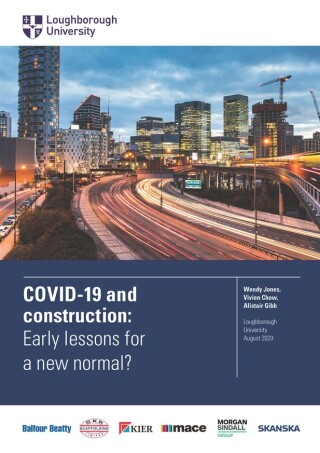Although total output on construction sites has been reduced by the constraints imposed by social distancing requirements, output per person appears – in some cases at least – to have gone up.
Reasons for this include better task planning, reduced waiting time between tasks, increased space and therefore less ‘overlap’ of trades, more use of technological solutions, more responsibility for individuals and less time spent in meetings.
The research was carried out by Loughborough University at five sites with the participation of Balfour Beatty, GKR Scaffolding, Kier, Mace, Morgan Sindall and Skanska UK.
Typical comments received included: “50% workforce reduction but only 30% reduction in output” and “With the productivity and the new ways of thinking we believe we only need 7½ people to do the same as 10 people”.
The report of the findings, Covid-19 and construction: Early lessons for a new normal?, states: “Overall project progress i.e. whether, and to what extent, projects had fallen behind the pre-Covid-19 expected programme was variable. It was influenced by a range of factors including having fewer workers on site, difficulty getting materials, and specialist suppliers being closed due to lockdown. Some tasks took longer than usual due to the need for workers to maintain social distancing.
“A range of mitigating measures were put in place. One project introduced a second shift to step up construction whilst still having fewer workers on site at any one time. Other tasks were rescheduled or carried out in different ways: one site used offsite manufacture to reduce the need for workers to be in close proximity, although this increased direct costs.
“Individual or gang productivity/effectiveness was considered to have improved to some extent on all five main sites: i.e. there was higher output per worker, even if total site output was reduced by having fewer workers. [note: our emphasis]
“Factors seen as contributing to this improvement included:
- Better and more detailed task planning
- More space, fewer people, and less overlap of trades in the workplace improves gang/task productivity
- Better planning by workers e.g. preparation of workplaces re tools and materials
- Less double handling of materials
- Fewer people ‘hanging around’ waiting to start work/tasks
- More streamlined worker flow due to workers staggering their start times, reducing the need to queue for site access or changing rooms
- People chatting less (due to distancing, one-way walkways etc), less talking on phones
- On one site there was a perception that those who had returned to site were the more
- motivated workers, the ‘team-players’
- Some workers may also have been enthusiastic and energised at returning to work after furlough.”
The report continues: “A strong finding from the research was the perceived benefit of more sequencing of trades and reduced overlaps, also reducing the number of workers assigned to a particular task or area. The general view was that this had a positive impact on workflow, work quality and worker effectiveness/productivity. This approach has a lot in common with Lean methodologies in manufacturing, which seek to reduce waste and improve productivity and quality. Changes reported in this research related mostly to the planning and execution of particular tasks. Additional benefits may be achievable with earlier planning i.e. incorporating these approaches at project design stage. Increased use of offsite manufacture might also align with this.
“Whilst such changes may be beneficial in cost and quality terms, it was also acknowledged that working this way is likely to take longer and might extend programme times. Consideration will be needed within the sector, and in discussion with clients as to whether this is a realistic way for construction to move forward. Long term adoption of these working styles might also have workload implications for some staff in management and specialist roles which would need to be factored in. It is similarly important to consider the impact on the frontline workforce. The perception of interviewees was that workers were happy with this way of working and appreciated being able to get on with their work efficiently. However, in the longer term there may be a risk of increased worker fatigue if there are fewer opportunities for informal down time, particularly in jobs which are physically or mentally demanding.
“Increased planning was necessary to sequence tasks more effectively. It also led to improved understanding of tasks – planning in greater detail, with less decision-making ‘on the hoof’. Planning to this level is not new, but it is perhaps one of those features which separates excellent projects from the rest and would benefit from being adopted more widely.
“The benefits seen in tidiness and housekeeping partly related to having fewer staff and more sequenced work. However, they also reflected a change in culture, and improved enforcement on some sites and therefore could be sustainable. Planning had an impact here also, in ensuring that materials were not delivered before they were needed.

“Some changes in shift time were reported, either staggered starts (to support social distancing) or the addition of a second shift, to increase productivity. Increased variability in work patterns could have substantial benefit longer term in the sector, allowing workers greater flexibility to work in ways which support their commuting or family needs.”
Interviewees were also asked about their senior managers.
“On some sites, there was a reported lack of senior leadership visibility due to them working from home. This was seen as a lack of support to on-site employees in one or two cases, e.g. failure to understand the challenges the site was facing, and there was some conflict between those on site and those working elsewhere (one interviewee referred to the ‘bedroom brigade’).
“There were also a small number of suggestions that low visibility of senior managers may have had an adverse impact on site behaviours in some cases; offset by an observation of the benefits of not having too many senior managers visiting site in their ‘shiny new PPE’.
“Conversely, there were observations on some sites that templates and guidance from their parent organisation had been very helpful when they were planning adaptations. One site reported that several senior managers from a subcontractor had worked on site alongside frontline workers for several weeks. As a consequence, they developed a better understanding of some of the challenges faced by their workforce and were able to redesign office systems to make life easier and improve efficiency.”
Throughout the report, it highlights what the authors see as opportunities for construction arising from lockdown lessons.
For example, it says: “Senior management engagement on site has been a characteristic of good project management and this is strongly supported by this study. However, it needs to be more than just a token involvement. Senior managers working alongside frontline workers could be a brave but potentially game-changing initiative.”
The report concludes with some final thoughts:
“The way in which the construction sector has adapted to the challenges of Covid-19 has highlighted its flexibility, resilience, and ability to solve problems. It has enabled several projects to move forward with innovations which might otherwise have taken several years to embed. It has also inspired many to raise their game and has challenged some conventional thinking about the ways in which projects are planned and undertaken.
“There is, however, a high potential for things to drift back towards ‘business as usual’ as Covid-19 related constraints are relaxed and as commercial pressures once again come to the fore. It is strongly recommended that individual companies and projects conduct a ‘lessons learned’ review before long to capture the changes made and ensure that positive changes are captured and embedded.
“It is important that the sector takes full advantage of this uninvited learning opportunity, engaging in wider discussions about the culture and accepted norms of construction and what benefits might accrue from rethinking these.”
Skanska’s Humber Tunnel project was one of the sites studied. Dylan Roberts, Skanska’s health, safety and wellbeing director, said: “Following our work with the Construction Leadership Council on the industry-wide site operating procedures, I felt that we should obtain an independent review of our perception that workforce engagement and planning of work activities had improved. This research is an external verification of the great work done by site staff and provides a positive view of workforce productivity.
“No one could have predicted the impact this pandemic would have on our onsite and remote work delivery, while maintaining optimum safety guidelines and procedures. Covid-19 has shown our industry to be at its most collaborative and innovative when it’s been most needed.”
Got a story? Email news@theconstructionindex.co.uk




